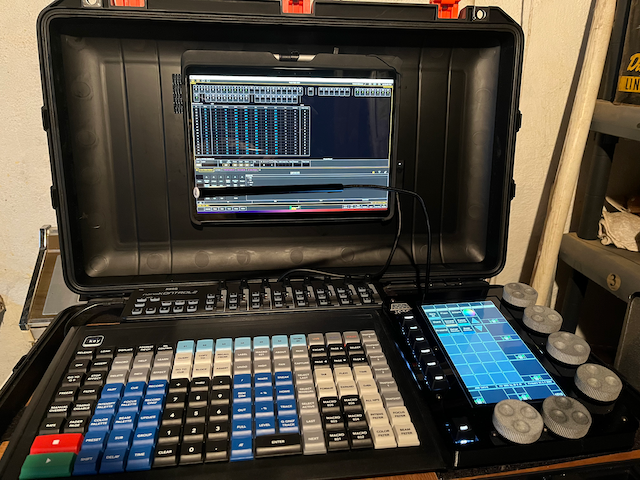The last Process Trailer that I programmed was a bit of a mess for me because I had no system in place to set up my Nomad rig for such a thing. Everything needed to sit in my lap or be attached to the tow trailer and though we got it done, I made a note to figure out a nomad case setup when I had time. With the strike continuing, I’ve obviously been given the time. This is what I cam up with and the significant parts and a description of the process. I don’t in any way claim this is a perfect setup for everyone, but I write this to share my experience for you to freely adapt.

Control Items
It’s all run off of the Surface Pro 8, which is attached with 3M Dual Loc 2” x 4”. The Surface itself is in a Kensington case. The buttons are a CMDKey, the encoders a JOSC and the faders are a Nanokontrol2. I used Showcockpit to link the Nano and Eos, but there are free options you could use as well. All of the control items sit on top of a 1/4” luan ply base that is sealed and has quite a bit of velcro atop it to receive the velcro on the bottom of the control gear. The CMD keys is shorter than the JOSC device, so I built a little platform for it, as well as a little shelf for the Nanokontrol2, which is the shortest of all three. There is a hole under the shelf to route the power and USB cables into the case.
Inside, there is a Surface Dock powering all the usb devices (the older version, as it has 4 USB ports plus network port and two mini display ports). Also, there is an EN4 node which connects to four DMX ports on the back of the case. It also acts as a tiny hub, accepting the network from the Surface and then passing it on to the network port in the back of the case. The tray itself is propped up by some pluck foam I had leftover from another project.
The Case
After way too much thought, I went with a Pelican Air 1555. It’s lightweight and solid and had enough space for everything (barely, but it works). My favorite detail about the case itself is the black body with the orange handles. As purchased from Colorcase, it was the same price as the one without the orange latches, and a little design detail goes a long way with me.

Ports
The ports in this build are all weather resistant, most with an IP 67 rating. From left to right, there is a recessed Edison port, an ethernet port and four DMX ports. They are attached with machine screws and nuts. Size 6 in the US (not sure what standards in other countries) and 1/2” long. There were a couple of place where I wish I had used 3/4” length because the plastic of the case would rise when drilled out and make it tricky to get the threads started. I used marine grade adhesive around each port to seal out dust and water. If you order the DMX ports- don’t forget the little rubber cap, which is sold separately.
Edison Receptacle: https://www.amazon.com/dp/B07LC686S8?psc=1&ref=ppx_yo2ov_dt_b_product_details
DMX Port Cap: https://www.fullcompass.com/prod/584310-neutrik-scfdx-top-d-series-xlr-f-top-dust-protection-cover
For no reason I can explain, my favorite port is this one, located in the upper right hand corner of the 1/4” luan ply that supports all of control items.

It obviously receives the LED lamp (very important as the CMDKeys are not backlit) and has space for a USB drive.
https://www.amazon.com/dp/B09XBK2ZSQ?ref=ppx_yo2ov_dt_b_product_details&th=1
Speaking of the LED light, it also came from Amazon and seems pretty great. I should probably buy a spare since it seems like the first thing that will break or be lost.
https://www.amazon.com/dp/B00MIQUJQ4?psc=1&ref=ppx_yo2ov_dt_b_product_details
Here is a shot of the inside of the case for those who want to see it. I know, I need to take some more time to neaten the cable, and/or order some shorter lengths of the cables to use in the first place. I’m surprised how much cable length I ended up burying inside. The surface dock is attached to the EN4 with velcro.

So far I’m very happy with the build. I think it solves the problems I had with setup time on atypical locations. Feel free to ask anything in the comments, or just share pictures of your builds!
Pingback: Tiny Tip: OSC Go Command – Mark LaPierre Lighting
Pingback: Revised Nomad Case – Mark LaPierre Lighting